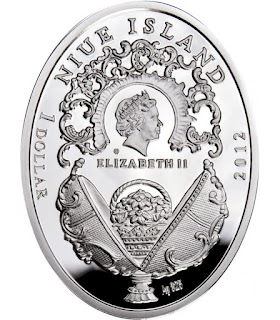Niue 1 Dollar Silver Coin 2012 Rosebud Faberge Egg
Series: Imperial Fabergé Eggs
Obverse: At the bottom – open „Spring Flowers Egg” (1899-1903) with a miniature basket and a bouquet of anemones. Above the basket – the effigy of Her Majesty Queen Elizabeth II with an inscription: ELIZABETH II and the mint mark (m/w). Around – a decorative, neo-rococo ornament. Along the rim – the issuer’s name: NIUE ISLAND, the face value: 1 DOLLAR, the hallmark (Ag 925) and the year of issue – 2012.
Reverse: The beautifully crafted reverse features the Rosebud Egg (1895), the first Faberge egg presented by Tsar Nicholas II to his bride Alexandra. Once opened, this strawberry red egg with a diamond Cupid's arrow reveals a yellow enameled rosebud, which blooms to disclose a ruby and diamond-set Imperial crown. Imperial Faberge Eggs got their name due to the fact that they were made for Alexander III and Nicholas II of Russia. The reverse image is embellished with two colored Swarovski crystals to fully express the finesse and magnificence of the original Rosebud Egg. The coin has been issued with the limited mintage of 9999 pieces worldwide.
Year of Issue: 2012.
Metal: Silver.
Silver Fineness: Ag 925/1000.
Content: 0.54 Troy OZ.
Denomination: 1 NZD - legal tender in New Zealand.
Weight: 16.81 g.
Diameter: Ellipse 39 x 29.20 mm.
Quality: Proof.
Mintage: 9,000.
Exterior Decoration: Zircons and Elements in Polished Finish.
Producer: Mint of Poland (Mennica Polska).
Series: Imperial Fabergé Eggs
Imperial Faberge Eggs is a magnificent series of minted replicas of works by Carl Peter Faberge and his assistants. Thanks to the exuberance, intricacy and splendour of decoration, Faberge Eggs have gained a huge popularity as jewelry masterpieces. Now, struck in .925 proof silver, they are sure to become an extravagant and luxurious addition to any modern coin collection.
Rosebud egg - Faberge Egg
The Rosebud egg is a jewelled enameled Easter egg made by Michael Perchin under the supervision of the Russian jeweller Peter Carl Fabergé in 1895, for Nicholas II of Russia, who presented the egg to his wife, Empress Alexandra Feodorovna. It was the first egg that Nicholas presented to Alexandra.
Surprise
The egg opens like a bonbonnière to reveal a yellow-enamelled rosebud, in which the two surprises were originally contained. The surprises are missing, but they were a golden crown, with diamonds and rubies, and cabochon ruby pendant. The crown was a reference to Alexandra Feodorovna's new role as Empress of Russia, following the accession to the throne of her husband, Nicholas II of Russia.
History
After the death of Alexander III of Russia, his son, Nicholas married Princess Alix of Hesse and by Rhine, who subsequently became Empress Alexandra of Russia, following the accession to the throne of her husband, Nicholas II of Russia. Princess Alix missed the rose garden of Rosenhöhe, Darmstadt, and so this egg reminded her of them during her first Easter with her new husband. The familiar yellow rose in 1895 was the yellow China tea rose that had been introduced by Parkes from China in 1824, re-bloomed in fall and was a staple of milder gardens than Saint Petersburg, where it was not hardy. Yellow roses were the most valued ones in the Empress' native Germany.
The egg embodied Fabergé's embrace of Neo-Classicism, in opposition to the dominance of Art Nouveau in late 19th century contemporary design. Fabergé charged 3,250 rubles for the egg.
In 1917 the egg was confiscated by the Russian Provisional Government and later sold to Emanuel Snowman of the jewellers Wartski around 1927. It was owned by a certain Charles Parsons in the 1930s, and was lost for decades, amid rumours that it had been damaged in a marital dispute. It was this damage that helped Malcolm Forbes identify the egg when he purchased it in 1985 from the Fine Art Society in London. In 2004 it was sold as part of the Forbes Collection to Viktor Vekselberg. Vekselberg purchased some nine Imperial eggs from the collection, for almost $100 million.
The egg is now part of the Victor Vekselberg Collection, owned by The Link of Times Foundation, and housed in the Fabergé Museum in Saint Petersburg, Russia.

